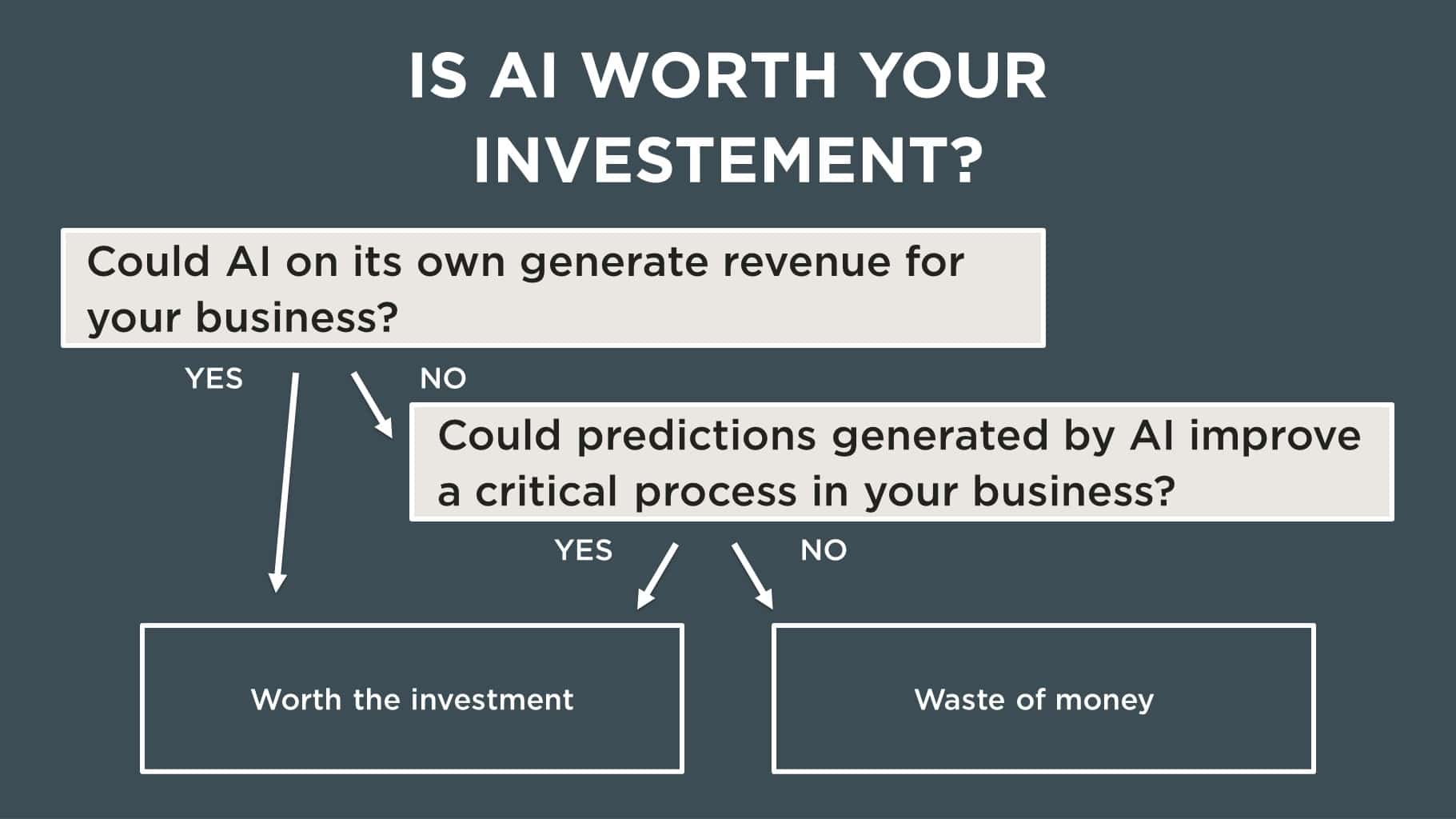Main Takeaways:
- Artificial intelligence (AI) solutions are tools that use historical information to make predictions about the future. But not all predictions are valuable to everyone.
- Unlocking the value contained in your data starts with the identification of your organisation’s sustainable data advantage and selecting those use cases that best fit your organisation’s overall strategy and design.
- The best way to do this is by bringing together the worlds of data, AI, innovation, and organisational change in a Data Design Sprint: a few days of intense collaboration and creativity to develop your roadmap towards a data-driven organisation.

“We have so much data!”
Many organisations, big and small, are now aware of the potential upside data and artificial intelligence (AI) can bring to their organisation. As a result, I hear “we have a lot of data, but we do not really use it” many times a week when speaking with potential clients. Regardless of industry, size, or history, what these companies need to do is identify their sustainable data advantage, and find out how to use it to strengthen their products and services. In other words, every journey towards a data-driven organisation should start with the question:
What information is unique to my organisation and how can it be leveraged?
Identifying Your Sustainable Data Advantage
AI solutions are tools that use historical information to make a prediction about the future. Not all predictions are valuable to everyone. As a hospital director, for example, it is invaluable to know how many Corona patients you can expect, but knowing that the share price of a certain bank is likely to go down is much less interesting. To generate a positive return on your AI investments, it is therefore essential to develop solutions that are closely aligned with your organisation’s ambition and strategy. This results in the right level of commitment required to develop a future-proof roadmap towards a data-driven organisation. An organisation that is still your organisation but powered by data.
Data as a Source of Value
Better predictions will help you to better manage your business. The most valuable predictions are predictions that require a great deal of accuracy, or that need to be made repeatedly. Additionally, when you are the only one being able to make that prediction accurately, because you are the only one with access to the right data, the prediction creates a competitive advantage for your organisation. We refer to the data underlying such valuable predictions as your sustainable data advantage.
For example, it is essential for a bank to know how high its reserves need to be to cover future losses. Keeping a buffer that is too high will negatively impact the bank’s margins, while holding back too little could result in bankruptcy. An accurate prediction is therefore essential. To do that, it must evaluate for each of its millions of customers whether they will pay back their loans or not. Making such predictions without an algorithm would be impossible. Their real-time transaction data provides the bank a sustainable data advantage that can be leveraged to accurately predict the required buffer.
Similarly, a consortium of general practitioners (GPs) could leverage its database of historical diagnoses and prescriptions to suggest treatment options to its GPs. Such a database, to which sole practitioners will not have access, creates a sustainable data advantage for the consortium.
Asking the Right Questions
What is the best next move in a chess game? And the one after that? If you are an experienced chess player (and there would actually be a game underway), you are likely to have a pretty good answer to these questions. However, if you are unsure whether the black queen starts on a white or a black square, you will probably have a pretty hard time coming up with a valuable answer. I often use this anecdote to encourage people to start experimenting with advanced data analytics, because if you have never thought of how AI could improve your business, it is highly likely that your first guess will not be the silver bullet. In other words, coming up with useful applications of AI requires practice. Within most organisations there will be plenty of ideas for such experiments floating around. By asking questions such as.
- What are your main processes?
- What data do you collect, or could you collect, during those processes?
- What information does that data contain?
- For whom is, or could, that information be valuable (within or outside of your organisation)?
- How valuable is it and how much effort is it to extract that value?
You can select the right experiments and maximise the return on your AI investments. Additionally, the following thought experiment helps select the right initiatives.
Thought experiment for selecting the right AI initiatives: assume that the technology will work.
When evaluating the various alternatives, assume that you will be able to gather the required data and extract the desired information from it (i.e. the technology will work); then focus on the impact that the solution will have on the organisation if you operationalise the tool. What will it do to my processes? What will the impact be on my people? Will it have an impact on my reputation?
Asking the right questions during the AI-strategy development process will ensure that the best initiatives (with the optimal balance between impact and effort) are selected, ensuring that you will develop value-adding AI solutions that are based on your sustainable data advantage. If you additionally learn how to run efficient experiments with the end user in mind (a topic for another time), your AI strategy is bound to give your organisation a great productivity boost.
Compressing This Process Into a Design Sprint
Unlocking the value of your data is complex. Not only does it require advanced IT infrastructure and complex algorithms, but it also takes a shift in mindset and reorganising key processes. As a result, many organisations run local experiments that never lead to any real value creation. One of the main reasons is that these organisations do not think the impact of the solution through and choose the wrong experiments. Some simply do not want to deal with the complexity required to operationalise their ideas. A way to overcome these challenges is by compressing the strategy creation process into a Data Design Sprint with a multi-disciplinary team of operational, strategy and technology experts. During the Data Design Sprint, you develop your roadmap towards a data-driven organisation in just a few days, through a series of carefully crafted diverge-and-converge activities. It is based on the principles of Design Thinking; it boosts creativity and is highly energetic, ensuring:
- Speed: You compress months of work into a few days of focus and productivity.
- Collaboration: Stakeholders create a deeper appreciation for each other’s work.
- Validation: The impact on people, processes and technology is validated from all angles.
If done well, the result of the Data Design Sprint is a future-proof roadmap towards a data-driven organisation. An organisation that leverages its sustainable data advantage to make faster and better decisions.
Would you like to know more?
Get in touch with Rik van der Woerdt at rik@adc-consulting.com, or check our contactpage.






